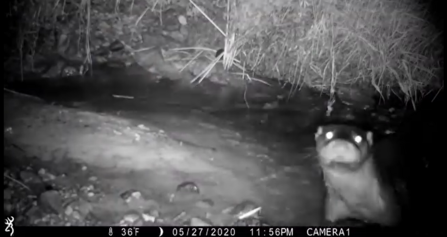
An otter spotted on one of our camera traps.

An otter spotted on one of our camera traps.
Camera traps are digital cameras connected to a sensor which is triggered by movement, there’s no actual trapping of animals despite the name. The camera takes an image or video of whatever is in frame and saves this to a memory card. They are one of the least invasive methods of monitoring species in their natural habitats, as cameras can be left for months before retrieval. Camera trap records also provide a verifiable dated record for species, which is hugely beneficial for monitoring species distribution over time.
Camera traps are used by conservationists to monitor animal populations, observe natural behaviour and estimate population size (amongst other things!). In recent years camera traps have become popular amongst those of us wanting to see the comings and goings in our own back gardens.
Camera traps can be attached to trees, posts or stakes. However, there are a few rules to be followed when setting them up. When choosing a new home for your camera trap, make sure that you follow these rules:
Once you’ve chosen your location, you’re ready to set the camera up! Make sure the object to which you’re attaching the camera trap is secure to avoid damaging the equipment and prevent it blowing in the wind, which takes lots of pictures you then have to wade through. Also check there are no waving branches or grass in the frame. Branches can be cable-tied, while grass can be weighed down using fallen branches.
You’ve finally got you memory card with all your pictures back and see you’ve captured some lovely images of our native wildlife, including house sparrows and hedgehogs galore. But so what? Aren’t these species really common anyway, who will even want to see?
Loads of people! Conservationists, ecologists, local groups, environmental charities, local record centres (like our lovely ERIC North East), land managers, government agencies, the list goes on. House sparrows have seen a decline of 71% between 1977 and 2008. Hedgehogs in urban areas have begun to recover according to the most recent “The State of Britain’s Hedgehogs” report, however this is after a long period of decline. In contrast, the hedgehog population in rural areas is seeing a wide decline of between 30 to 75% nationally. We take so many of these animals for granted because they’re “common”, but we stand a real risk of losing them forever if we neglect to look after them too. Camera trap images are invaluable in detecting and protecting rare species. However, lots of the time more common species are completely overlooked and not reported, even though they are just as valuable.
In conclusion, the reason camera trap images are so important is that they provide a record which is undeniably true. It’s hard to say a species isn’t present when faced with a clear image! The issue which arises is surveys being conducted for a specific species, and any other species going unreported. Any species caught on a camera trap should be recorded. Either sent to your local records centre, local recording group, or Wildlife Trust through Nature Counts. This will build up an accurate record for more species and support future conservation action for currently threatened species and those we haven’t realised need help yet.
Any questions? Please send me an email at emily.frith@northwt.org.uk